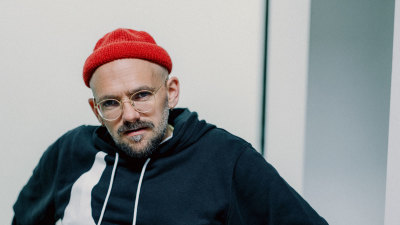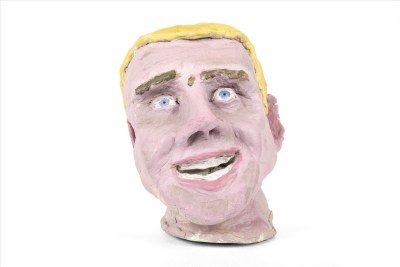The wizard of Oxfordshire: in the studio with Mick Rooney RA
The wizard of Oxfordshire: in the studio with Mick Rooney RA
By Fiona Maddocks
Published 27 November 2014
Behind garage doors at his Cotswolds home, Mick Rooney RA conjures a magical world on canvas.
-
Mick Rooney emerges from his Oxfordshire home – “a late 1960s jerry-built bungalow,” as he describes it – as if dressed to match his surroundings: grey jersey, putty-coloured trousers, white socks and brown shoes blend seamlessly with the fallen leaves, autumn sunshine and pale honey-coloured Cotswold stone of the house. He looks, too, as if he might have stepped out of one of his own magical pictures – a shock of white hair and alert but benign eyes giving him the appearance of a friendly wizard. Indoors, the first thing you notice is a shiny new garden trowel hanging on the coat stand, then three Mexican ritual masks on the wall. You never know what you might encounter in an English cul-de-sac.
His house is covered in a net of scaffolding while builders work on a kitchen extension. Everything is in a state of flux, if not chaos. “So you are seeing a place in transition,” Rooney chuckles, making good Italian coffee in a pot big enough to entertain several neighbours. He once spent time working as a chef. Jars of newly made jam and tomato chutney – “Ah, the alchemy of chutney!” – sit on the window ledge.
He sometimes works at a table in the sitting room (above), which is dominated by one of his own pictures and overlooks the garden. The studio itself is to the side of the house, converted from the garage. In its current improvised state it feels rather like one. Is the washing machine a permanent fixture? “That’ll move to the new bit soon. Really I do love having everything close to hand,” Rooney says. “I visit some of my artist friends and they have to walk miles just to get themselves a cup of tea… But then as you see in my work, I am attracted by the small-scale. Indian and Persian miniatures have been a big influence.”
-

Mick Rooney RA, Lunar Picnic.
Oil on canvas. 75 x 99 cm.
-
Born in 1944 in Epsom, Surrey, to Geordie parents, Rooney studied at the Royal College of Art and spent a formative time at the British School of Rome in the late 1960s: “a wonderful time of glamour and creativity, linen suits, dark glasses and hand-made shoes, all very Fellini-esque and Cinecitta?.”
After a brief period as an abstract painter, he returned to a narrative world he first encountered as a 14-year-old schoolboy, when he was lucky enough, through his art master, to meet Stanley Spencer RA. “We were taken on a trip to Cookham. Stanley met us off the coach. To see him working on Christ Preaching at the Cookham Regatta (1959) left an indelible mark.”
Rooney has had studios in Hastings and Mortlake, coming to the Oxfordshire town of Charlbury around eight years ago. “Getting out of London was important. I didn’t really know the middle of England. I had only passed through it. Then I found Charlbury. There was a railway station. And it’s near Stow-on-the-Wold, where the Fosse Gallery [with whom he is associated] is based. It is perfect.”
The studio has no view. Do the skylights face north? “Oh I’ve no idea. I’ve never worried about that kind of thing.” A long table is covered in tubes of oil and gouache, and jars of fine brushes. He recently started reworking the picture currently on the easel, of figures in a misty landscape. “I’m a great believer in not throwing work away but trying again. Do you think it looks like dawn?” I agree it does. “Maybe I’ll call it Early Morning, Oxfordshire?”
Another picture, “one of my lunatic ones”, is a ghostly image of two dancing girls at a window illuminated by a full moon. Details in his work, however poetic the subject matter, are always precise. He uses reference books, “on anything – food, mushrooms, a Victorian study of the life of a bee.” A wall of storage cupboards promises an air of orderliness. “Of course I start well, then I can’t remember where the hell I have put anything.”
Moonscapes occupied by toy trains, goldfish, semi-clad women doing cat’s cradle or cooking secret recipes, or selling liquorice or gathering apples, wide-eyed, strange, playful and all-knowing: where do these minutely observed, dreaming, pastoral stories in pictures come from? He speculates that time spent as a child with his mother, a mental health nurse, revealed to him the painful strangeness of human nature. “I’ve always had a regurgitative mind! My head is a storehouse, with a wide visual vocabulary. But I’m not daft. If I don’t know how to draw a bit of jungle, I go to Kew Gardens and look. It’s part of the adventure.”
Members in Focus: Mick Rooney RA is in the Belle Shenkman Room in the Keeper’s House at the RA until 23 April 2015.
Fiona Maddocks is a journalist and broadcaster. Her latest book is Harrison Birtwistle: Wild Tracks (Faber, 2014).




